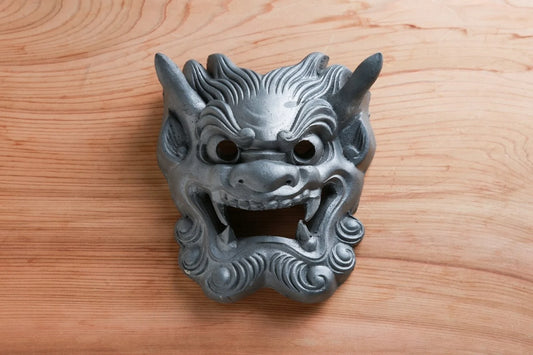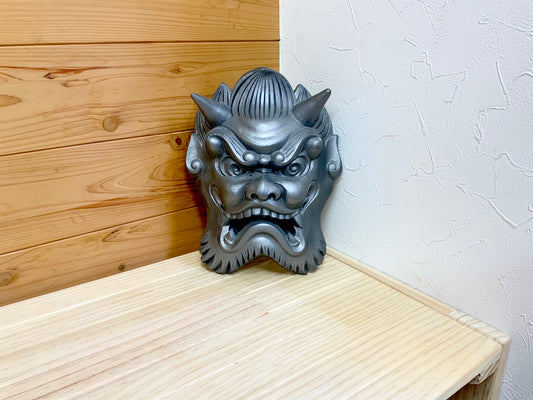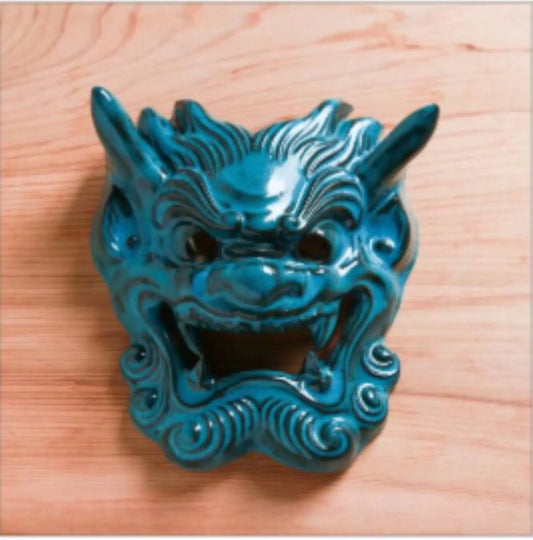About ONIGAWARA
鬼瓦(おにがわら)とは
鬼瓦とは、日本の伝統建築において屋根の端部に据えられる装飾瓦の一種で、主に魔除けや厄除けの意味を持ちます。日本独自の意匠として発展しました。
強い目つきで悪魔や悪い出来事などを追い払い、家と家族を守ります
名前のとおり「鬼」の顔を模したものが代表的で、怖ろしげな表情をもつ鬼が災いや悪霊を追い払い、建物や住む人々を守ると信じられています。特に寺社仏閣や城郭、武家屋敷などに多く見られ、屋根の棟の端(大棟・隅棟)に設置されることが一般的です。
鬼瓦には、鬼面のほかにも獅子、龍、蓮の花、家紋などが意匠化されたものもあり、その表現は地域や時代、職人の個性によって多彩です。また、建築物の格式を表す装飾としての役割も果たしてきました。
現代においても、鬼瓦は日本建築の象徴的存在として継承されており、文化財の修復や現代建築における和風演出、さらには美術工芸品としても注目されています。
What is an Onigawara?
Onigawara is a type of decorative tile placed on the edge of a roof in traditional Japanese architecture, and is primarily used to ward off evil and misfortune. It has developed as a uniquely Japanese design.
Its intense gaze drives away demons and bad events, protecting the home and family.
As the name suggests, it is most commonly seen in the shape of an oni (demon), and it is believed that the frightening expression of the oni drives away disasters and evil spirits, protecting the building and its inhabitants. It is particularly common in temples, shrines, castles, and samurai residences, and is generally placed on the edge of the roof ridge (the ridge or corner ridge).
In addition to demon masks, onigawara can also be designed with lions, dragons, lotus flowers, family crests, and other designs, and the expressions vary depending on the region, era, and individuality of the craftsman. It has also played a role as decoration to show the status of the building.
Even today, onigawara continue to be a symbol of Japanese architecture, and are attracting attention for their use in the restoration of cultural properties, for the Japanese style in modern architecture, and even as art and crafts.
kamon collection
-
~Wall ONI Color Collection ~ いぶしIBUSHI
Ordinarie pris $160.00 USDOrdinarie prisEnhetspris per$300.00 USDFörsäljningspris $160.00 USDRea -
~Wall ONI Color Collection ~ 青藍 SEIRAN
Ordinarie pris $150.00 USDOrdinarie prisEnhetspris per$300.00 USDFörsäljningspris $150.00 USDRea -
Onigawara statue New products, commemorative bargain sale
Ordinarie pris $150.00 USDOrdinarie prisEnhetspris per$230.00 USDFörsäljningspris $150.00 USDRea -
~Wall ONI Color Collection ~ 翠綠 SUIRYOKU
Ordinarie pris $160.00 USDOrdinarie prisEnhetspris per$300.00 USDFörsäljningspris $160.00 USDRea



